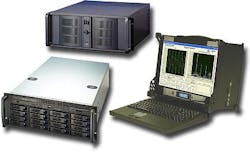Serial FPDP rugged data recorders for aircraft, ships, and vehicles introduced by Pentek
UPPER SADDLE RIVER, N.J., 24 May 2012. Pentek Inc. in Upper Saddle River, N.J., is introducing the Talon family of high-speed, multi-channel Serial FPDP turnkey rugged data recorders for capturing streaming sources such as live transfers from computer or sensor data aboard aircraft, ground vehicles, ships and submarines, and other harsh-environment applications.
The Model RTS 2716 commercial rackmount, the Model RTR 2736 rugged portable, and the Model RTR 2756 rugged rackmount data recorders use disk storage to achieve aggregate recording rates as fast as 2 gigabytes per second.
The Talon recorders have built-in Windows 7 Professional workstations with Intel Core i7 processor to help users route data to drives, networks, and I/O channels, as well as install post-processing and analysis tools to operate on the recorded data.
Data files stored in native Windows NTFS format include time stamping, recording parameters, and optional GPS information. Files also can be downloaded through gigabit Ethernet, USB ports, eSATA3 ports, or written to optical disks using the built-in 8X double layer DVDplus-or-minus R/RW drive.
The model 2736 and model 2756 recorders are configured with solid-state disks while the model 2716 has hard disks. The drives are hot-swappable.
The recorders are compatible with the VITA 17.1 Serial FPDP specification, and support 1.0625-, 2.125-, and 2.5-gigabit-per-second link rates. The recorders can be ordered with either four or eight bidirectional Serial FPDP ports and with copper or optical interconnect options.
Pentek SystemFlow recording software has a Windows-based graphic user interface GUI to configure and control the system. For more information contact Pentek online at www.pentek.com.
Follow Military & Aerospace Electronics and Avionics Intelligence news updates on Twitter

